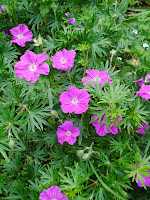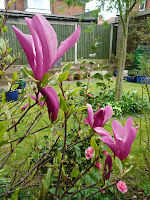The herbaceous border is starting to fill out well, although there are still a few gaps where I need to improve the planting scheme. My favourite three plants for summer in the herbaceous border are the vibrant red Lychnis Chalcedonica, the pretty pink sweetly scented Phlox Paniculata and the classic white Chrysanthemum Maximum, better known as the Shasta Daisy.
Lychnis Chalcedonica, also known as Jerusalem Cross or Maltese Cross, was introduced into Britain in the 14th century and has always been linked with returning pilgrims. Although it was collected in the Middle East it actually originated in European Russia. The first part of the name comes from 'lychnos', the Greek word for lamp, and is thought to refer to the woolly leaves which were used as wicks for oil lamps. The second part of the name comes from 'Chalcedon' which is the classical name for Kadekoy, the district of Turkey opposite Istanbul. Flower heads composed of small bright red cross shaped flowers are borne on upright stems above the mid green leaves in early to midsummer. The plant grows to about 3 feet tall and will self seed freely. It likes moist but well drained fertile humus-rich soil and prefers a position in full sun or light dappled shade.
Phlox Paniculata is a lovely scented border plant which has flowers in varied shades from white through to pink, red, purple and blue, often with contrasting centres. The flowers appear throughout summer into autumn, and are long lasting when cut. I have three varieties in my garden at the moment and intend to plant more. They are a really good reliable hardy perennial with a long flowering season. The delicate fragrance is an added bonus. Grow them in any moist fertile soil, positioning them in full sun or partial shade. This welcome addition to the herbaceous border was introduced into Britain in 1730 from the Eastern United States.
The perennial Chrysanthemum Maximum, also known as the Shasta Daisy, is one of my favourite plants. The lovely white daisy flowers are up to 3 inches across with a golden eye and make a cheerful display from June to August. There are varieties available with semi double or double flowers but I think the single flowered variety is the most beautiful. It grows to between 24 and 36 inches in height and likes a sunny position in a well drained fertile soil. Propagate by taking 2 - 3 inch long cuttings of basal shoots in March/April or by lifting and dividing established clumps, again in March/April.
 It's a good idea to incorporate a few evergreen plants into the garden to give a bit of winter greenery. There are plenty of evergreens to choose from and one of the best for green and gold colour is the Euonymus Fortunei 'Emerald and Gold'. This is easily grown in ordinary garden soil in sun or partial shade. I planted mine as a tiny shrub over 15 years ago and it has grown into a handsome 5ft tall specimen. It is a good choice for evergreen hedges as it withstands regular pruning to maintain shape. It may need some protection from extreme winter weather but will tolerate the average British winter.
It's a good idea to incorporate a few evergreen plants into the garden to give a bit of winter greenery. There are plenty of evergreens to choose from and one of the best for green and gold colour is the Euonymus Fortunei 'Emerald and Gold'. This is easily grown in ordinary garden soil in sun or partial shade. I planted mine as a tiny shrub over 15 years ago and it has grown into a handsome 5ft tall specimen. It is a good choice for evergreen hedges as it withstands regular pruning to maintain shape. It may need some protection from extreme winter weather but will tolerate the average British winter. Choisya Ternata (Mexican orange blossom) has glossy dark green leaves which are aromatic when crushed and produces sweetly scented white flowers in spring. I grow the golden leaved variety called 'Sundance' which brings a welcome bright splash of colour to the garden on dark winter days. Choisya has a wide spreading and rounded bushy habit and will grow to about 6ft tall and 6 - 8ft wide. It is pollution tolerant and therefore suitable for town gardens. Grow in any well drained garden soil in a sunny position. It will tolerate partial shade but the leaf colour is better in full sun. In very cold gardens it is best grown against a south facing wall as the foliage is prone to frost damage.
Choisya Ternata (Mexican orange blossom) has glossy dark green leaves which are aromatic when crushed and produces sweetly scented white flowers in spring. I grow the golden leaved variety called 'Sundance' which brings a welcome bright splash of colour to the garden on dark winter days. Choisya has a wide spreading and rounded bushy habit and will grow to about 6ft tall and 6 - 8ft wide. It is pollution tolerant and therefore suitable for town gardens. Grow in any well drained garden soil in a sunny position. It will tolerate partial shade but the leaf colour is better in full sun. In very cold gardens it is best grown against a south facing wall as the foliage is prone to frost damage. .A smaller pollution tolerant evergreen shrub which can be grown in containers or in the border is the Skimmia. These shrubs have oval green leaves and produce creamy white flowers in 2 inch long conical spikes which are followed by bright red berries which persist throughout the winter. As with holly bushes, you will need to plant male and female cultivars of this shrub close to each other in order for the female cultivar to produce berries. But a single shrub will produce flowers regardless. There is a red flowered male variety called 'Rubella' which is particularly attractive and this would be my choice. I am currently growing a variegated form of this shrub in a pot on the patio. The pot has been placed against the patio wall for protection as I am not sure if this variegated Skimmia will be as hardy as the other varieties, but it has a very pretty leaf edged in cream.
.A smaller pollution tolerant evergreen shrub which can be grown in containers or in the border is the Skimmia. These shrubs have oval green leaves and produce creamy white flowers in 2 inch long conical spikes which are followed by bright red berries which persist throughout the winter. As with holly bushes, you will need to plant male and female cultivars of this shrub close to each other in order for the female cultivar to produce berries. But a single shrub will produce flowers regardless. There is a red flowered male variety called 'Rubella' which is particularly attractive and this would be my choice. I am currently growing a variegated form of this shrub in a pot on the patio. The pot has been placed against the patio wall for protection as I am not sure if this variegated Skimmia will be as hardy as the other varieties, but it has a very pretty leaf edged in cream.











 .
.











 .
.










